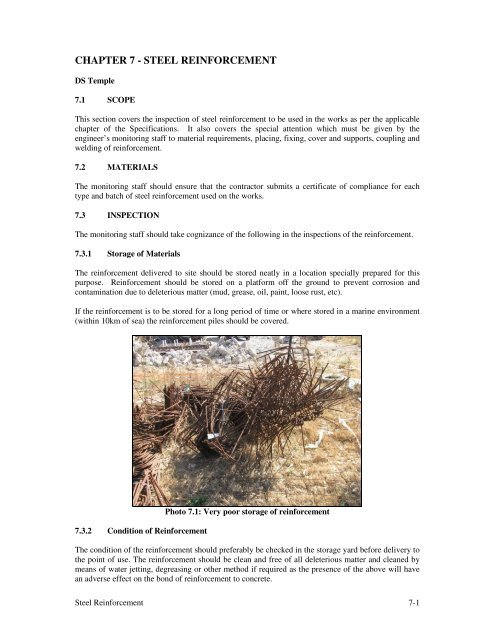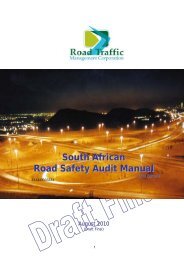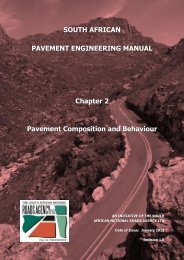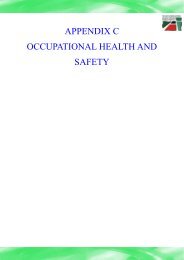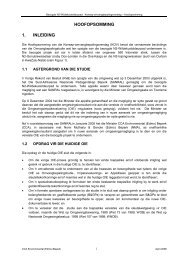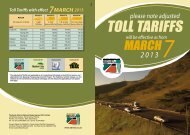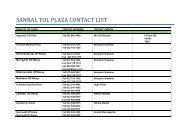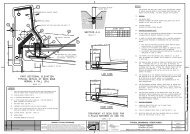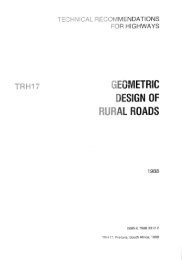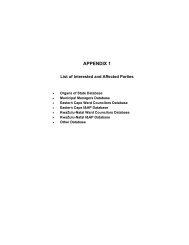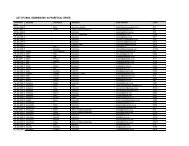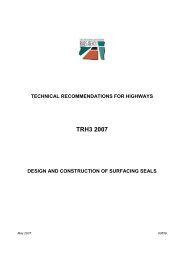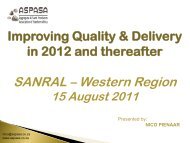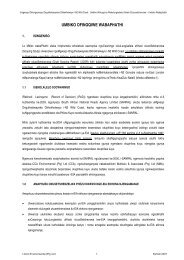CHAPTER 7 - STEEL REINFORCEMENT
CHAPTER 7 - STEEL REINFORCEMENT
CHAPTER 7 - STEEL REINFORCEMENT
You also want an ePaper? Increase the reach of your titles
YUMPU automatically turns print PDFs into web optimized ePapers that Google loves.
<strong>CHAPTER</strong> 7 - <strong>STEEL</strong> <strong>REINFORCEMENT</strong><br />
DS Temple<br />
7.1 SCOPE<br />
This section covers the inspection of steel reinforcement to be used in the works as per the applicable<br />
chapter of the Specifications. It also covers the special attention which must be given by the<br />
engineer’s monitoring staff to material requirements, placing, fixing, cover and supports, coupling and<br />
welding of reinforcement.<br />
7.2 MATERIALS<br />
The monitoring staff should ensure that the contractor submits a certificate of compliance for each<br />
type and batch of steel reinforcement used on the works.<br />
7.3 INSPECTION<br />
The monitoring staff should take cognizance of the following in the inspections of the reinforcement.<br />
7.3.1 Storage of Materials<br />
The reinforcement delivered to site should be stored neatly in a location specially prepared for this<br />
purpose. Reinforcement should be stored on a platform off the ground to prevent corrosion and<br />
contamination due to deleterious matter (mud, grease, oil, paint, loose rust, etc).<br />
If the reinforcement is to be stored for a long period of time or where stored in a marine environment<br />
(within 10km of sea) the reinforcement piles should be covered.<br />
7.3.2 Condition of Reinforcement<br />
Photo 7.1: Very poor storage of reinforcement<br />
The condition of the reinforcement should preferably be checked in the storage yard before delivery to<br />
the point of use. The reinforcement should be clean and free of all deleterious matter and cleaned by<br />
means of water jetting, degreasing or other method if required as the presence of the above will have<br />
an adverse effect on the bond of reinforcement to concrete.<br />
Steel Reinforcement 7-1
Photo 7.2: Corroded reinforcement<br />
It is very important that reinforcement is not corroded to the point that pitting of the bars is evident.<br />
Pitting is a potential flaw which under cyclic loading can reduce the life of the structure significantly.<br />
If pitting of steel is greater than that permitted by SANS 920, the reinforcement should be rejected or<br />
further guidance sought from the engineer.<br />
7.3.3 Bending Dimensions<br />
Photo 7.3: Reinforcement damage during demolition<br />
Bending dimensions of reinforcement should be frequently checked to ensure that the bars will fit into<br />
the formwork and provide enough cover. The inside radius of bends is very important to ensure that<br />
the bars were not overstressed during bending. Monitoring staff should have suitable templates for<br />
checking radius available on site.<br />
Steel Reinforcement 7-2
The minimum radii of bends are:<br />
• High Tensile Steel = 3 Bar diameters<br />
• Mild Steel = 2 Bar diameters<br />
7.3.4 Placing and Fixing<br />
Placing and fixing of reinforcement into the forms for the structure is one of the most important<br />
aspects of the construction of a structure. Special care should be taken by the monitoring staff to<br />
ensure that the reinforcement is placed and fixed in accordance with the design by verifying the<br />
following:<br />
(a) Type of steel (R or Y)<br />
(b) Diameter of bar<br />
(c) Bar mark<br />
(d) Spacing of bars<br />
(e) Concrete cover (refer to item 7.3.5 below)<br />
(f) Laps as per drawing (refer to designer if in doubt)<br />
(g) Grouping of bars to create space for placing and vibrating concrete.<br />
(h) All reinforcement should be adequately tied together and properly supported to ensure that<br />
the reinforcement does not displace and move in position during the concreting process as<br />
this will affect the cover to bars and the effective functioning of the concrete member.<br />
(i) Adequacy of stools and clips provided (need for stools where not provided).<br />
(j) Where bars are detailed to project out of a member (such as parapet anchors) they must be<br />
accurately placed and held in position.<br />
General neatness of the fixed reinforcement in the forms is<br />
always an indication of the accuracy of the placing and fixing<br />
and the contractor should be required to carry out corrective<br />
actions until the cages of reinforcement are fixed properly.<br />
7.3.5 Cover and Supports<br />
WARNING<br />
Do not allow the use of heating<br />
to bend reinforcement.<br />
WARNING<br />
Lack of cover on parapet<br />
anchors/starter bars results in<br />
loss of durability, pop outs and<br />
corrosion of reinforcement<br />
The minimum cover requirements are usually given on the drawings and/or in the project<br />
specifications.<br />
When checking the placing and fixing of reinforcement the monitoring staff must pay special attention<br />
to ensure that the specified cover to reinforcement is achieved. Cover has the most significant effect<br />
on the long term durability of reinforced concrete and therefore of the structure.<br />
Excess cover should be avoided as micro cracking due to bending stress can result in the growth and<br />
development of cracks and resulting corrosion of reinforcement or member loss due to spalling. The<br />
correct cover is required to ensure that reinforced concrete members meet their specified design<br />
requirements.<br />
Steel Reinforcement 7-3
Photo 7.4: Insufficient cover to reinforcement<br />
cage in forms<br />
Photo 7.5: Correct cover blocks in place<br />
In order to ensure that the reinforcement does not move during concreting the Specifications give<br />
specific requirements for the types and specifications of spacer blocks and stools and these<br />
requirements should be strictly adhered to.<br />
Photo 7.6 (a) & (b): Reinforcement corroding due to lack of cover<br />
Steel Reinforcement 7-4
Special attention should be given to the cover blocks and their mix design. Samples of cover blocks<br />
should be submitted by the contractor to the engineer for approval before the work commences. Care<br />
should be taken to ensure that the cover blocks are made in such a way that they integrate with the<br />
parent concrete. Only concrete cover blocks as specified in the Specifications may be used.<br />
Photo 7.7: Failure of member due to too much cover<br />
Photo 7.8: Corroded reinforcement resulting in loss of concrete<br />
Stools are not necessarily detailed on the<br />
drawings. They must be robust enough to<br />
perform well under concreting and other<br />
superimposed construction loads. The engineer<br />
has the authority to order the contractor to add<br />
additional stools to ensure the reinforcement is<br />
fixed securely and does not swivel or move<br />
during concreting. The provision of concrete<br />
cover to reinforcement stools should be checked.<br />
WARNING<br />
A wide range of plastic cover blocks are<br />
available but owing to problems associated<br />
with their use, are not permitted by a number<br />
of road authorities. If permitted they should<br />
only be used with great caution and subject to<br />
successful trials and ongoing monitoring. This<br />
is necessary as many are prone to bending or<br />
buckling under load and are sometimes clearly<br />
visible on the finished concrete surface.<br />
Steel Reinforcement 7-5
Approved cover meters will generally be provided on site. Where specified in the project<br />
specifications, cover to reinforcement should be confirmed after casting of the concrete by the use of<br />
electromagnetic cover meters. If the cover is substandard the engineer may instruct the contractor to<br />
remove and reconstruct the concrete member or agree to acceptable remedial measures with the<br />
employer.<br />
7.3.6 Laps and Joints<br />
Laps, joints and splices should be placed as indicated on the drawings. As a general rule the lap length<br />
should not be less than 45 times the diameter of the smaller bar at the splice or lap. The lap positions<br />
should only be moved when the casting sizes are such that the contractor makes a specific request to<br />
do so. In all such cases any of these changes should be referred to the designer.<br />
It is good practice for laps and splices to be staggered as indicated on the drawings. This facilitates<br />
better placing of concrete and improved stress distribution in the concrete section, but may not be<br />
preferred by the Contactor in terms of casting construction joints.<br />
7.3.7 Welding<br />
The welding of reinforcement is generally not permitted for high tensile steel as heating hot rolled bars<br />
causes brittle fracturing of the reinforcement. In the case of cold worked deformed bars, heating<br />
causes the reinforcement to revert to mild steel as it loses the effects of strain hardening. Welding<br />
may be permitted on mild steel in very specific cases, which should be referred by the monitoring staff<br />
to the engineer.<br />
Where welding of reinforcement is specified on the drawing the monitoring staff should ensure that<br />
the welding is carried out strictly in accordance with the Specifications and that specialized testing is<br />
carried out as required.<br />
7.3.8 Mechanical Couplers<br />
Mechanical couplers may be specified where concrete members are coupled together due to staged<br />
construction processes, or where space restrictions do not permit normal laps and splices.<br />
The contractor should submit to the monitoring staff (for approval by the engineer) all the test<br />
certificates for the proposed proprietary products as required in the Specifications.<br />
7.3.9 Conformance with Project Specifications<br />
The monitoring staff must check the Project Specifications for specific requirements related to types of<br />
reinforcement to be used, specific cover, cover block types, etc, and should ensure the compliance<br />
thereof for the duration of the contract.<br />
7.4 <strong>STEEL</strong> <strong>REINFORCEMENT</strong>- CONSTRUCTION MONITORING CHECK LIST<br />
The monitoring staff should use the “Steel Reinforcement - Construction Monitoring Check List” as<br />
far as possible to ensure the quality of the installation of steel reinforcement.<br />
Steel Reinforcement 7-6
INDEX TO APPENDICES<br />
7A - <strong>STEEL</strong> <strong>REINFORCEMENT</strong><br />
Steel Reinforcement 7-7
CONSTRUCTION MONITORING CHECKLIST<br />
PROJECT NO. / NAME: .......................................................................................................................................<br />
INSPECTOR’S NAME(S): ....................................................................................................................................<br />
STRUCTURE: ........................................................... ELEMENT: ..............................................................<br />
ACTIVITY AND DETAILS<br />
1. GENERAL<br />
1.1 Storage of reinforcement<br />
1.2 Condition of reinforcement<br />
1.3 Bending dimensions<br />
2. PLACING AND FIXING<br />
2.1 Type of steel (R or Y)<br />
2.2 Diameter of bars<br />
2.3 Bar marks<br />
2.4 Spacing / Number of bars<br />
2.5 Concrete cover (general)<br />
2.6 Laps (alternating)<br />
2.7 Grouping of bars (clearances)<br />
2.8 Fixing ties adequate<br />
2.9 Spacers<br />
2.11 Stools in place<br />
2.12 Projecting anchor bars<br />
2.13 Cleanliness of reinforcement<br />
3. COVER AND SUPPORTS<br />
3.1 Minimum cover as per drawing<br />
3.2 Spacer block type<br />
3.3 Spacer block positions<br />
3.4 Spacer block spacing / Number<br />
provided<br />
3.5 Stool spacing / Number provided<br />
3.6 Stool fixity<br />
4. SPECIAL REQUIREMENTS<br />
4.1 Welding procedure approved<br />
4.2 Welding quality<br />
4.3 Mechanical couplers<br />
4.4 Coupler type approved<br />
4.5 Installed correctly<br />
4.6 Other special requirements<br />
APPROVAL<br />
Y/N N/A Comment<br />
APPENDIX 7A<br />
<strong>STEEL</strong> <strong>REINFORCEMENT</strong><br />
CHECK LIST<br />
SIGNED DATE<br />
Steel Reinforcement 7-8


